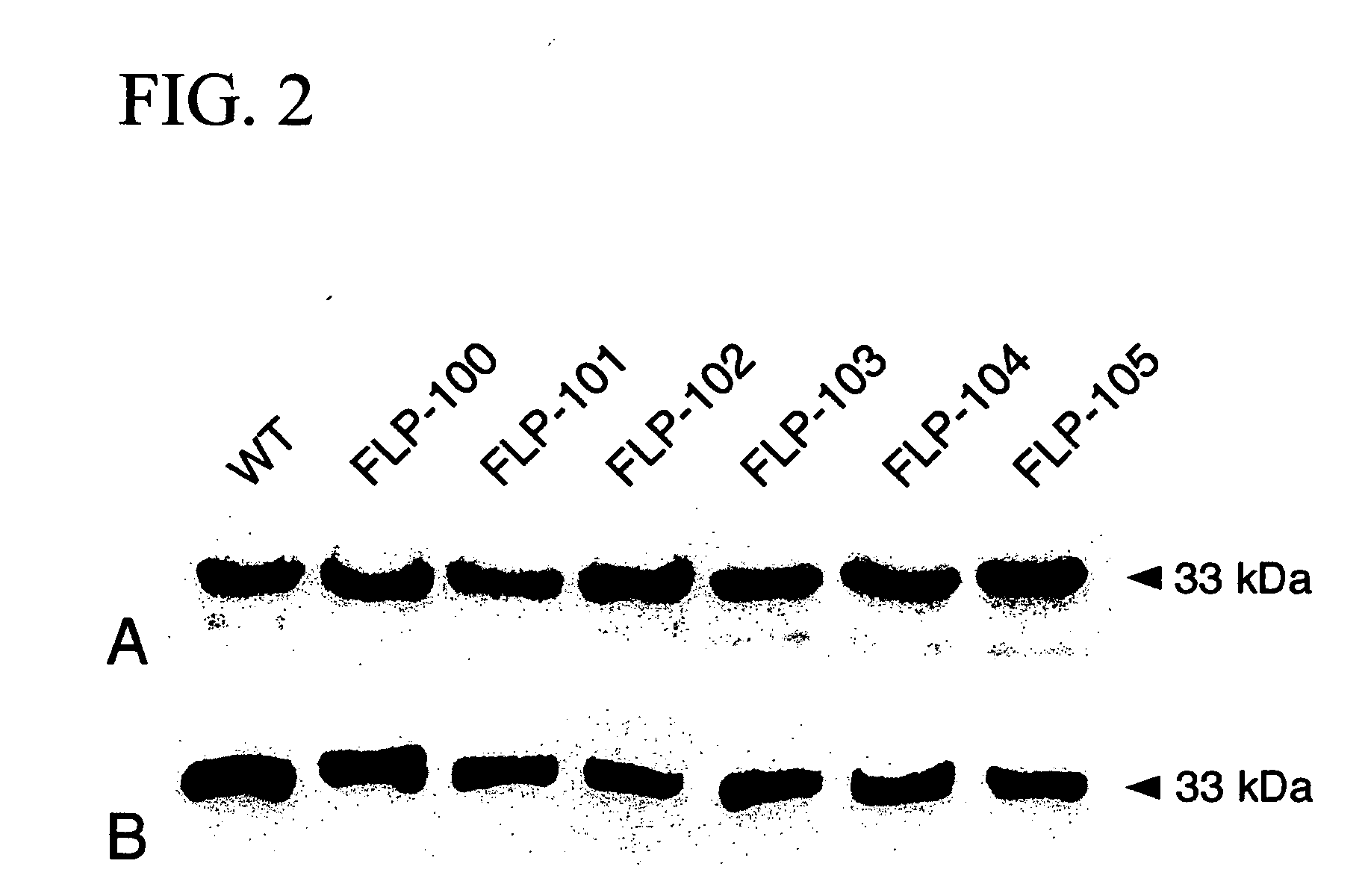Pokeweed antiviral protein polypeptides with antiviral activity
- Summary
- Abstract
- Description
- Claims
- Application Information
AI Technical Summary
Benefits of technology
Problems solved by technology
Method used
Image
Examples
example 1
Rational Design of Mutant PAP Proteins: Molecular Modeling
[0101] Molecular modeling studies for the rational design of recombinant PAP proteins were performed, as described in detail previously (Rajamohan F, et al., 2000, Journal of Biological Chemistry, 275(5):3382-3390; Rajamohan, F., et al., 2001, Journal of Biological Chemistry, 276(26): 24075-81; Rajamohan, F., et al., 2001, Biochemistry, 40:9104-14). The molecular model of the PAP-ribosome (large subunit) complex was derived from the 2.4-Å crystal structure of the large ribosomal subunit from Haloarcula marismortui (Protein Data Bank access code 1FFK) (Ban et al., (2000) Science 289:905-20.) and the crystal structure of PAP-nucleotide complex (access code 1pag).
Structure-Based Design of Nontoxic Mutant PAP Proteins with Potent Anti-HIV Activity.
[0102] Molecular modeling studies indicated that ribosomal RNA and HIV-1 RNA adopt distinctly different binding modes in their interactions with PAP. In a systematic search for spec...
example 2
Engineering, Expression and Purification of Recombinant Mutant PAP Protein
[0108] Recombinant wild-type PAP (PBS-PAP) was obtained by subcloning the PAP-I gene (amino acids 22 to 313) into the pBluescript SK− expression vector (Rajamohan F, et al., Protein Expression and Purification, 16(2): 359-368). The PAP-I gene was amplified by polymerase chain reaction (PCR) using the following primers PAP-Bam (5′ CGC GGA TCC AGT GAA TAC AAT CAT CTA CAT GTT GGA AGT ACC 3′) (SEQ ID NO: 2), which introduces a BamHII site at the N-terminus, and PAP-H3 (5′ GCC TCT TAT TTA AGC TTT ATA ATA TAG TTG GAG 3′) (SEQ ID NO: 3), which introduces a HindII site at the C-terminus. A uracil-containing template of PAP was obtained by transforming E. coli CJ236 with the recombinant plasmid PBS-PAP. The oligonucleotides used for site-directed mutagenesis were synthesized on the 200 nmol scale and HPLC purified by Biosynthesis Inc. (Lewisville, Tex.). A site-directed mutagenesis procedure was performed...
example 3
Binding of Native Eukaryotic Ribosomes and Synthetic Ribosomal Protein L3 to Mutant PAP Protein
Ribosome Binding Assays
[0112] Ribosomes were isolated from rabbit reticulocyte-rich whole blood (Pel-Freez Biologicals, Rogers, Ariz.) as described previously (Rajamohan, F., et al., 2001, Biochemistry, 40:9104-14). Total ribosomes (30 μg) were incubated with 5 μg of wild-type or mutant PAP proteins to a final volume of 100 μl in binding buffer and incubated at room temperature for 1 hour. After incubation, ribosomes were pelleted by centrifugation at 300,000×g for 30 minutes at 4° C. The pellets were washed two times with solution D (10 mM Tris-HCl, pH 7.5, 1 mM KCl, 0.1 M MgCl2) and resuspended in 20 μl of PBS (137 mM NaCl, 2.7 mM KCl, 10 mM Na2HP04, 1 mM KH2PO4, pH 7.4). The protein samples were resolved on a SDS-12% PAGE gel and transferred onto a polyvinylidene difluoride membrane (Bio-Rad) using the Bio-Rad Trans-Blot apparatus, as described previously (Rajamohan F, et al., Protei...
PUM
| Property | Measurement | Unit |
|---|---|---|
| Fraction | aaaaa | aaaaa |
| Angle | aaaaa | aaaaa |
| Volume | aaaaa | aaaaa |
Abstract
Description
Claims
Application Information
 Login to View More
Login to View More - R&D
- Intellectual Property
- Life Sciences
- Materials
- Tech Scout
- Unparalleled Data Quality
- Higher Quality Content
- 60% Fewer Hallucinations
Browse by: Latest US Patents, China's latest patents, Technical Efficacy Thesaurus, Application Domain, Technology Topic, Popular Technical Reports.
© 2025 PatSnap. All rights reserved.Legal|Privacy policy|Modern Slavery Act Transparency Statement|Sitemap|About US| Contact US: help@patsnap.com



